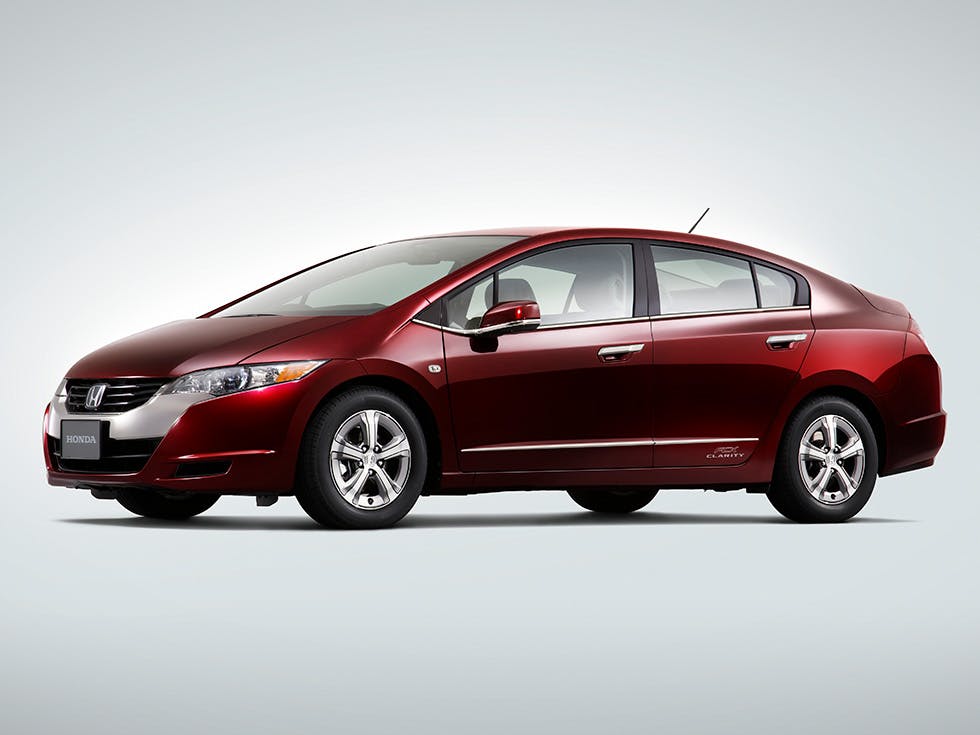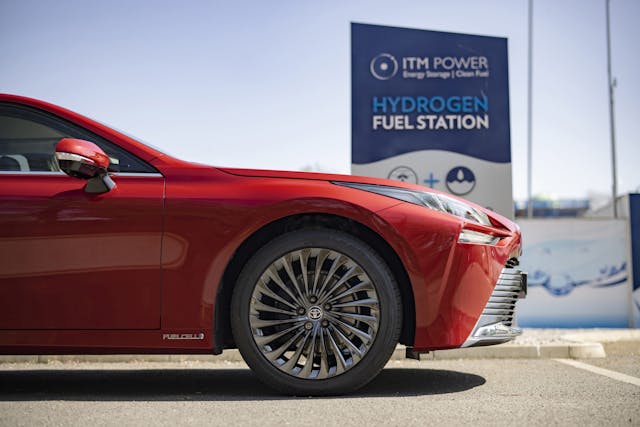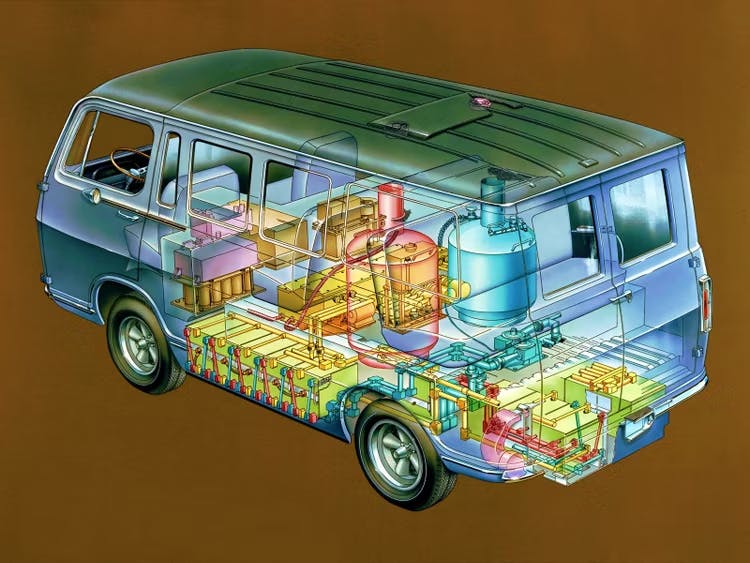After 215 years, is it finally hydrogen’s time to shine as fuel?
Hydrogen is the perfect fuel. For a start, it’s the most abundant element in the universe, so we’ll never run out of it. If you burn it in a combustion engine or feed it to a fuel cell the only byproduct is water.
So why haven’t we been driving hydrogen-powered cars and flying in hydrogen-powered planes for decades? Big-oil conspiracy theories aside, there are a few issues with H2.
It may be quite literally everywhere, but extracting it isn’t that easy. The most straightforward way is to split water (H2O) into hydrogen and oxygen using electrolysis. However, to do this at any practical scale requires a lot of electrical energy, which has to come from somewhere—preferably from a renewable source such as solar, wind, or wave power. If the electricity isn’t sustainable, then the net environmental benefits of hydrogen are negated.
Next up is the problem of storage. Hydrogen is the lightest element and has a tendency to escape its confines. The solution so far has been to compress the gas into liquid form and store it in high-pressure tanks. In theory, “pellets” of solid ammonia borane, which are capable of storing hydrogen, could also release the gas in situ through a catalytic reaction.
Finally, there’s the Hindenburg effect. It may have been 85 years ago but newsreel footage of the world’s largest airship going up in flames is one of the most enduring images of the 20th century and and still conjured in the minds of many at the merest mention of hydrogen.
Nonetheless, automotive engineers have been doggedly trying to get hydrogen into cars since the dawn of driving. At the cusp of 2023, we might just be on the cusp of an H2 future with big players such as Toyota and new niche marques hoping to get us gassing up on the most bountiful element in the cosmos.
Let’s see how things have progressed.
1800s
If Swiss engineer François Isaac de Rivaz had gotten his way, then hydrogen would have fueled the motorized carriage from the very beginning.
In 1807 he patented a hydrogen-powered internal-combustion engine, with the gas contained, somewhat impractically, in a balloon. A year later he installed the apparatus in a vehicle, which was arguably the first automobile.
In 1860 Belgian Étienne Lenoir had rather more success with his one-cylinder, two-stroke engine installed in his Hippomobile. He sold close to 400 examples, almost 30 years before Karl Benz patented his Motorcar.
Around the same time, work on fuel cells had also begun, based on a concept first demonstrated by British scientist Humphrey Davy.
In 1839, Davy’s countryman William Grove, a polymath chemist, physicist and lawyer created what he called a “gas voltaic battery” which produced electricity from a reaction between hydrogen and oxygen using a platinum catalyst. The term “fuel cell” was coined a few years later by Carl Langer and Ludwig Mond.
1930s

In 1933 Norway would take the first step towards its dream of a hydrogen-based transport system when the Norsk Hydro power company engineered an H2-powered truck, with its combustion engine fueled by hydrogen extracted from ammonia.
Six years later in the U.K., Francis T. Bacon produced a 5-kW fuel cell— the most powerful to date. With gasoline in short supply during World War II, ingenious Russian military technician Boris Shelishch converted around 200 GAZ-AA trucks to run on hydrogen in just 10 days of 1941.
1960s
Two decades passed before serious consideration was given to hydrogen again, and it came from polar opposite directions.
In Texas a high-school senior named Roger Billings converted a Ford Model A to run on H2, which he stored in two cylinders in the pickup’s bed. The vehicle took first place at the 1966 International Science Fair in Dallas and would help Billings win a grant from Ford to continue his research as an undergraduate.
Meanwhile, at General Motors, the biggest car maker on the planet, engineers unveiled the Electrovan, inspired by the fuel cells that powered NASA’s Apollo program.
The converted GMC Handi-van used 32 Pratt & Whitney cells spread throughout the floor of the van, helping to generate a range of 150 miles from tanks of liquid hydrogen and liquid oxygen that provided power.
It wasn’t a viable daily driver, though. Not only did the Handi-van require an auxiliary power unit it to get it going, the original pressurized tanks exploded and had to be replaced with cryogenic ones. The vehicle was so fiendishly complex that only one man ever learned to master it.
1970s

The gas crisis of the ’70s fueled plenty of experimentation, with Billings developing a hydrogen-powered VW Beetle that actually cleaned the air it took in, along with a Cadillac Seville which took part in President Jimmy Carter’s inauguration parade (above).
Chevrolet showed its H2-4 Chevy and BMW unveiled a 520 that could run on regular gas or on liquid hydrogen. At the Musashi Institute of Technology in Japan, meanwhile, a variety of different vehicles were also developed, dabbling in homogeneous charge ignition, direct injection, and other technologies that have only relatively recently made it into production vehicles.
1980s
Musashi pressed on into the ’80s, now trying turbos and two-strokes to perfect hydrogen combustion. In Germany, Mercedes-Benz got in on the H2 action, converting a 280 TE wagon and a TN 310 van to run on hydrogen as well as gasoline.
1990s

Hydrogen concept cars were now almost as abundant as the element itself. Mazda revealed that its rotary engine could happily run on hydrogen, showing the 1991 HR-X concept and the 1993 HR-X2. It even fitted a fuel cell to a Miata in 1994 and to a Demio in 1997.
GM produced a fuel-cell version of the Who Killed the Electric Car EV1, plus versions of the Opel Sintra and Zafira MPVs.
Mercedes-Benz debuted a series of NECAR concepts which started with a sizable MB-180 van in 1994. By 1997 the boffins had managed to shrink the tech down to fit in an A-Class known as the NECAR 3. BMW first showed a 728 sedan that ran on H2 and then went all-out with a V-12 powered 750i.
Honda began its FCX series of concepts which would actually lead to a production vehicle, but Daihatsu’s dinky Move, not to mention efforts to convert London’s famous black-cab fleet, were to no avail.
2000s

The concepts kept coming. Ford showed everything from a Crown Victoria to a Focus and Explorer could potentially be powered by a hydrogen fuel cell. VW displayed Golfs and Boras, there were Jeeps, Buicks, Hyundais, Minis, Toyotas, even Ladas.
However, only Honda actually made the leap into production as five 2002 Honda FCXs were leased to the City of Los Angeles, fitted with a Ballard fuel cell and Honda’s ultra-capacitors.
Mazda, as you’d expect, continued to go its own way, pressing ahead with H2 as fuel for the rotary engine and sending a fleet of four RX-8s to Norway, which boasted of having the world’s first hydrogen highway with a small number of hydrogen filling stations on the 380-mile route between Oslo and Stavanger. BMW also stayed true to its beliefs, sticking to V-12 power for the 2006 Hydrogen 7.
In 2007 Honda launched the FCX Clarity, making a hydrogen vehicle available to the general public for the first time since 1860. For $600 a month, buyers got 270 miles of range, zero emissions, and also next to zero places to fill their tanks. The only hydrogen stations were in Torrance, Santa Monica, and Irvine, California but Jamie Lee Curtis got one all the same.
2010s

Toyota finally unveiled its first series-production fuel cell vehicle in 2014. The Mirai was priced just shy of $60,000 and 200 were to be sent to the United States. A range of over 300 miles was slightly better than the Honda’s, but without much additional refueling infrastructure it was a car for Californian early adopters only.
2020s

The lack of practical refuelling stations remains the biggest problem today, but American hydrogen hypercar startup Hyperion is hoping to solve it—for its own customers, at least. Should buyers of the XP-1 need to exceed its claimed 1000-mile range Hyperion says it will soon have a network of mobile fuel stations across the U.S.A. which can refill tanks in just five minutes.
Toyota also continues to persevere, introducing a refreshed Mirai in 2021 and a fuel-cell version of the Hilux pickup in the U.K.
It’s showing hydrogen’s potential in motorsports with a World Rally–ready GR Yaris H2 which burns the gas in its turbocharged triple-cylinder motor. The engine is also fitted to a Corolla Cross H2 Concept car and Toyota says that it is “around 40 per cent along the path to the commercialisation,” but then adds that “it is not yet possible to say whether the technology will reach maturity for road cars.”
215 years later, hydrogen is still the fuel of the future.
Check out the Hagerty Media homepage so you don’t miss a single story, or better yet, bookmark it.





Here is the deal with Hydrogen.
The new fuel cell cars are great. I got to drive a porotype GM fuel cell vehicle a couple years ago and it drove fine.
There are two prime issue. One cost are still high as so few cells are being built. But the major issue is the ability to refuel is just not there and has not grown at all.
While Chargers may not be on every corner for a battery hydrogen refueling points are often not even in some cities let alone out in the country.
This disadvantage is just not going to go away soon.
The path forward here is in fleets. I can see these cells in city trucks and vehicles where they have their own refuel points and they can grow from there.
Also with the restart of the space program we will see again major jumps in technology like we did in the 70’s and 80’s. Things developed for space find their way to the market place and it helps lower cost with volume.
Fuel Cells and Batteries both will see significant gains in the NASA programs. While these programs cost large amounts of money they bring much greater return in technology that has given so much. We would not be conversing here today with out it and many here would not be alive with some of the gains we have made.
Until the fuel distribution situation is resolved Hydrogen Fuel Cells are going to be limited.
At the time of my drive in Los Angeles there If I recall were only 4 commercial refuel stations available for the whole area. Compare that to a charger where most can install in a garage in 80% of the cases Hydrogen has some work to do yet.
This is merely a great factalogica truth ! And reality that is being spoken here🗣️👌✨! Until the the dis-interested masses have been Awaken 👀 Ed I personally don’t have much prospects for the quick -ing effect taking 💤Hold👌?
Hydrogen can also be extracted from a methanol/water mixture, so you wouldn’t necessarily have to store hydrogen gas but instead carry liquid fuel that an onboard reformer processes into H2. They’re not cheap, but in mass production they might be price competitive with EV batteries.
https://rebresearch.com/hydrogen_generators.html
This is a nerve center issue that should have been Addressed! Like yesterday 👌? In the way of Human powered exercise tent cities Amalgamated geo- wind and solar What ever it takes took begin a step in the right direction.And to give Cali the edge or lead it used to hold 👍🥵👌🏆?
“to do this at any practical scale requires a lot of electrical energy” This is a false statement. I agree with hyperV6, fueling points are non-existent. The easy way out is electric recharge. Electric recharge stations are relatively cheap and easy to install. With Hydrogen you require cryo type storage for liquified hydrogen and pump systems to transfer hydrogen to the vehicle. Much like liquified petroleum and propane. Not necessarily as easy as a fuel pump or an electric plug in. I think hydrogen is great and super cheap but the infrastructure to use it is expensive and companies are lazy. Unless the government steps in and subsidies the infrastructure it won’t happen. Look how well the government is doing with our rail lines and airlines…..
Why do you say it’s a “false statement”? Facts and source, please.
However, I agree that, with the total lack of infrastructure and no viable home recharge capability, this is a non-starter – unless some miracle happens.
Site source?? spend 5 minutes looking on the interwebs.
This is America we can do anything thing that we desire 😢👌😊👍Send for me Bobby Houston of Hartford Connecticut I ‘ll show Ya’ll how 😊👀✨.Get your tent camps and modular air conditioning modules systems in place along with your multi-plexed exercise systems.For Electrical generation. And I am talking about all across the Land or country 😊🚭! How hard is That ⛏️🧩?With state and government grants Problem Solved!😊😇👍👌,?
Hydrogen has promise but it does not seem to have the force of government behind it like batteries and chargers do.
Bingo! Thanks for pointing out the Elephant in the room.
Gary Bechtold You knocked it out of the Park 🥎🍙 with that Reply 🎉! You my Friend have said Everything 😇🎉!
The city of Reykjavik tried a fleet of buses using hydrogen some years back, seems maintenance was a big issue – keeping them operational – did not work out at the time.
I did witness a few leaving vapor trails on cold days and thought it could lead to a fog problem if enough vehicles were using this as fuel – it never got that far though.
All I know is God runs the Universe on Hydrogen, seems “we” think “we” know better.
“If you burn it in a combustion engine or feed it to a fuel cell the only byproduct is water.” Not quite. Burning hydrogen also produces nitrogen oxide (NOx).
Aside from NOx, I have wondered, but never found an answer to the question of what the impact of millions of vehicles releasing water (vapor that is hotter than ambient temperature?) would be in an urban area.
They make such a big deal about the miniscule NOX emissions of H2 ICEs. In reality, they can be essentially eliminated through calibration and, whatever is left can be further reduced by catalytic converters to the tune of 97+%. NOX emissions from H2 ICEs is a red herring to be ignored.
Frank Bohanan well said👌👍😇✨ this was also a good Sientfic counter reply 🙋
Interesting article, a small note, the Swiss engineer’s first name is François (Françoise is a woman’s name, think Angelo vs Angela).
The future here is fuel cells creating electric for EV drive lines.
Running Hydrogen in a ICE is just not how this is going to play out.
The Fuel Cell tech got its start at NASA and when deep space was cut back investment slowed. Much of this was done at the Glen Center in Cleveland. With the increase in spending will see more gains and possibly more commercial application.
The Hydrogen GM Prototype I drove was just an EV with a cell that converted hydrogen to electric. It was great but like I said the refueling.
Ha! I posted my comment before seeing yours.
Maybe it’s obvious to the initiated, but it would have been nice if the author had distinguished which vehicles used hydrogen to replace gasoline as the combustible fuel, and which vehicles used hydrogen in a fuel cell that generated electricity to power an electric motor. There’s a big difference. One’s still an ICE and the other’s an EV.
Yo también creo que el hidrógeno tendrá mucho, pero mucho más éxito que otras opciones en los vehículos.
If you go to the web site below, you’ll see that there are more than a few hydrogen fueling stations in California. Fuel cost is still high and availability can be low or nonexistent because of the lack of production.
I attended Honda’s demonstration of the fuel cell Clarity when it hit the market and driving one was no different than driving a gasoline-fueled vehicle. The difference in its operation was in a slower startup. All the test drive vehicles were already running to hide this.
https://h2fcp.org/stationmap
Belgian Etienne Lenoir invented the internal combustion engine (based on a steam engine) but it ran on gas (no hydrogen). It was a stationary engine used in the industry to power tools. There is a story that he built his engine on a cart and covered some 20 miles in it near Paris, but there is no real proof of that. If it really existed, there was only one built, not 400. It is very well possible that 400 engines were built though.
The degree to which Hydrogen fuel cell technology is viewed as viable is directly proportional to the degree which Elon Musk is viewed as favorable by the media.
Left a few things out. Electrolysis is much more feasible when nuclear power genetation is used. Plenty of capacity gets added to the grid, for all EVs, with nukes. Zero carbon, proven and safe technology that’s consistent and reliable. BEVS and FCEVs will need nukes to increase grid capacity enough for them to grow. PHEVs, which can self-charge and have smaller batteries, will have to tide us over until grid capacity can catch up.
The distribution of H2 will be no more difficult than that for CNG. Fleets will lead the effort for H2 conversions. They will be able to use most of their existing equipment. The economics of H2 vs. CNG will affect how quickly this happens. Charging stations still have to be built, even when there is existing wiring. Upgrades, at a minimum, are usually needed. Fleets with existing CNG (or propane, etc.) fueling stations will have a head start.
H2 will be the preferred option for larger, heavier vehicles. Especially semis. Batteries weigh far too much in such applications, loads have to be reduced to compensate. That hurts profits. Then there’s the charging time with batteries, HUGE batteries, versus quick refueling with H2. Time is money for truckers. H2 is better.
BEVs will have a place, mostly in light duty vehicles. They won’t meet all needs so PHEVs will help advance electrification and provide mostly zero emission operation for most people, most of the time. Fossil fuels will still be around for a VERY long time, but synthetic carbon-neutral fuels and H2 will help reduce their footprint. There is no single answer that works for everyone, no matter what the EV evangelists say. All of the different options will keep improving. The market will ultimately choose what works best, regardless of government intervention and manipulation efforts.
Frank Bohanan well said👌👍😇✨